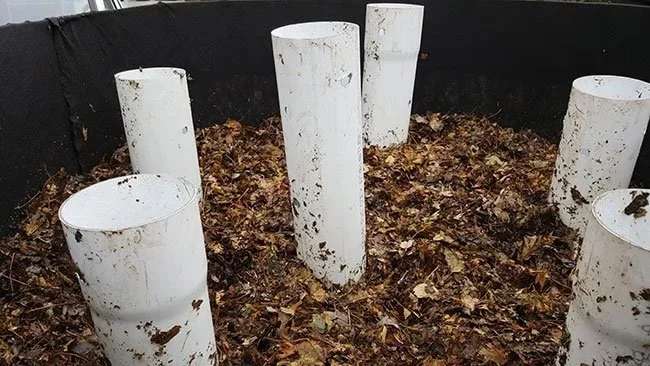Soil Ecology
Soil is not a sterile homogeneous material. Soil in its natural state is a living environment, teeming with biological activity functioning in a complex ecosystem. The types of life found in the soil are many, and the numbers of organisms are enormous. Plaster (1992) estimates that one-fourth teaspoon of a fertile soil (about one ml) contains:
50 nematodes 62,000 algae 72,000 protozoa 111,000 fungi 2,920,000 actinomycetes 25,280,000 bacteria
A handful of such soil may also contain several earthworms and many plant roots, insects, mites and spiders, and perhaps an indignant gopher or prairie dog.
Organisms serve a variety of functions in the soil ecosystem. Some of them are:
Recycling of energy and carbon - The decomposition of organic matter releases stored energy and produces carbon dioxide, which can then be reused by plants through photosynthesis.
Recycling of plant nutrients - The decomposition of organic matter transforms plant nutrients into available forms which can be taken up by plants.
Disease transmission and control - Some organisms cause or transmit diseases while others, such as Penicillium, produce substances which control disease organisms.
Nutrient/water absorption - Organisms such as fungi and actinomycetes form associations with plant roots and aid the plant in exploring the soil environment for water and nutrients.
Nitrogen fixation - Some organisms take nitrogen from the atmosphere and transform it into organic forms which are then utilized by other organisms in the ecosystem. Such organisms include bacteria in symbiosis with legume plants, blue-green algae, and some actinomycetes.
Soil mixing - Organisms that burrow through the soil mix it through their digging. Subsoil is brought up and mixed with topsoil, recycling the clays and minerals which had eluviated down out of the rooting zone.
Decomposition of chemical materials - Pesticides, petroleum products, and other organic chemicals are degraded by soil microbes; first into other organic materials, ultimately into carbon dioxide and water. Materials which resist microbial action may accumulate and lead to environmental problems.
Microorganisms and organic matter produced by soil organisms are important in the formation of soil structure. Humus and exudates of roots and microorganisms act as a glue, holding soil particles together. Fungal hyphae bind particles together. The surfaces of bacteria carry a net-negative charge, similar to clays, and have a similar effect on soil structure.
Soil organisms can be classified according to the method in which they obtain energy and carbon. Organisms are either autotrophs that obtain energy and carbon from inorganic sources, or heterotrophs that obtain energy and carbon from organic sources. Autotrophs get energy and carbon from either photosynthesis (photoautotrophs) or from chemical reactions (chemoautotrophs). Heterotrophs get energy and carbon from living plants or animals (consumers) or from dead organic matter (decomposers).
Autotrophs (energy and C from inorganic sources)
Photoautotrophs (energy and C from photosynthesis)
Chemoautotrophs (energy and C from chemical reactions)
Heterotrophs (energy and C from organic matter)
Consumers (energy and C from living organisms)
Decomposers (energy and C from dead organic material)
Soil organisms are often grouped into five classes:
animals
plants
bacteria
fungi
actinomycetes
Animals include earthworms, arthropods (insects, spiders, centipedes, etc.), and rodents (moles, gophers, prairie dogs, etc.). Earthworms have an enormous effect on the soil through their mixing of soil material and by ingesting organic matter. The organic matter remaining n their casts is partially digested, so the nutrients in it are more available to plants. Termites digest large amounts of organic matter, some of which is later available to plants, and also affect soil physical properties. Other arthropods are predators, feeding on other organisms. Nematodes are often predators in the soil, feeding on other microorganisms. Many of them have a detrimental effect on plant growth. Microscopic protozoa graze on bacteria, moving within thin films of soil water. When water or food are limiting they encyst, waiting until conditions improve.
Plants have major effects in the soil environment by the cycling of water and nutrients, production of organic matter, formation of pores by root growth, secretion of root exudates which promote soil aggregation, and production of organic acids which influence nutrient availability. Bacteria and actinomycetes that fix atmospheric nitrogen use root exudates for energy; root nodules provide a home for some of these microorganisms. Blue-green algae also fix nitrogen; especially in wet environments such as rice paddies and wetlands.
Bacteria have perhaps the greatest influence in the soil environment of all organisms. Species are either autotrophic or heterotrophic. They perform many functions in the ecosystem, most importantly in enzymatic transformations. They are able to oxidize or reduce many chemical elements in the soil. For example, nitrogen is tansformed from ammonium to nitrite and nitrate by two different species. Fixation of nitrogen from atmospheric N2 into organic forms is also performed by bacteria, either in symbiotic associations with plants or independently. The net-negative electrical charge on bacteria and organic materials produced by them are important in the formation of soil aggregates and soil structure.
Actinomycetes are a special type of bacteria. They are single-celled and small, but they have filamentous structures (mycelia) like fungi. They have important roles in the decomposition of organic matter, release of plant nutrients, and in some cases form symbiotic relationships with plants including nitrogen fixation. Many of our important antibiotics (all the mycin compounds such as streptomycin) were first discovered through the study of actinomycetes in the soil. Streptomyces spp. are responsible for the typical odor of a plowed field.
Fungi are very important in the soil ecosystem. The decomposition of organic matter releases plant nutrients into the ecosystem for other organisms to use. Some fungi form mycorrhizal associations with plant roots - plants provide the fungi with food (sugars and other root exudates) and the mycorrhizae provide the plants with enhanced availability of plant nutrients (P,Zn,Ca,Mg,Mn,Fe, and Cu). Some fungi are important in other ways: mushrooms are important food products; many molds, like Penicillium, produce useful materials such as antibiotics. Fungal hyphae also play a role in the developement of soil structure.
REFERENCES
Plaster, E. J. 1997. Soil Science and Management (3rd Ed.). Delmar Publishers, Inc., Albany.







